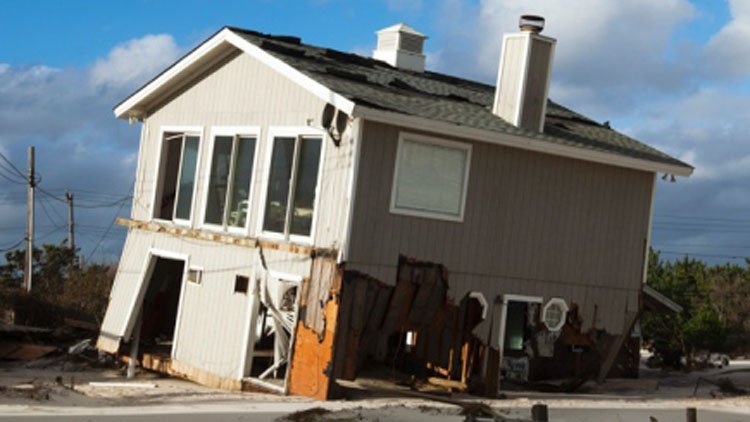
Firefighters braving gale-force winds to help homeowners who refused to heed evacuation orders. Police officers trudging through fast-moving floodwaters to rescue endangered civilians. Village workers risking their lives to save critical infrastructure.
These are among the stories from the more than 100 people who rode out the storm on Fire Island 10 years ago this fall when Sandy brought devastating storm surge and violent gusts on Oct. 29, 2012, leaving a trail of destruction in its wake.
“The morning superstorm Sandy hit, I was on this island,” Suffolk County Executive Steve Bellone reminisced during a Dec. 17 news conference marking the start of the $1.7 billion Fire Island to Montauk Point (FIMP) storm mitigation project. “I remember getting the call from the National Weather Service and they said that this storm is worse than predicted now and anyone who remains on Fire Island is in mortal danger. Those are words you don’t expect to hear.”
Sandy is considered the costliest storm to hit the area since the infamous Long Island Express of 1938 and fourth costliest in U.S. history after hurricanes Katrina, Harvey and Maria. Sandy breached the island in two places – the U.S. Army Corps of Engineers closed one in Smith Point County Park but the National Park Service left open the other in the Otis Pike High Dune Wilderness Area – damaged hundreds of the about 4,000 structures on the island and washed a dozen homes out to sea. Seven houses were swallowed by the sea in Davis Park, the hardest hit community, with the rest in Atlantique and Ocean Bay Park.
Fire Islanders’ eyewitness accounts from those communities and beyond remain just as poignant today as they were a decade ago.
WATER WORRIES
Two of the most dramatic stories to come out of Sandy involved a pair of village officials miles apart putting themselves in harm’s way to protect their local water supply.
Ocean Beach police officers had to physically remove Superintendent Kevin Schelling from the village’s oceanfront public drinking water well – which they did just as he managed to seal it to prevent salt water contamination from the incoming storm surge. And to the west, Saltaire Water Superintendent Larry Slack, armed with only a wrench, ripped off his shirt and dove into 3 feet of water on the Tuesday of the storm to close a fast-leaking fire hydrant water main on Pacific Walk that he had to first find and dig out submerged in a muck of water and sand, officials said after the storm.
In the Ocean Beach case, Mayor James Mallott ordered Ocean Beach Police Chief George Hesse and his team of officers to rescue Schelling.
“It was like a raging river,” Hesse had said, recalling the march up Bungalow Walk to find Schelling after the ocean broke through the dunes. “I’ve never been more proud to work with such a team.”
The Suffolk County Water Authority declared the water safe to drink in most communities a month later. Among the FIMP sub-projects slated to soon start is to move the Ocean Beach well further inland.
EYING THE EPONYMOUS ELEMENT
The abundance of water didn’t make it any easier for the firefighters of Fire Island. “We never went off duty,” Sean Coaffey, an Ocean Bay Park Fire Department firefighter, told the News after the storm.
Rescuing those who ignored the evac order was as harrowing as it was frustrating. “It wasn’t like a storm surge came out of nowhere,” said then-Kismet Fire Chief Dominic Bertucci, noting the three-day’s notice. “They put first responders in jeopardy … we were wading through waist-deep water to double check who stayed behind.”
The Woodhull School became a temporary shelter for about 20 of the people who ignored the mandatory evacuation order and either refused rescue or were out of reach of first responders.
Eight Fair Harbor Fire Department firefighters stayed in their firehouse until floodwaters started coming in, then brought their gear to a home in Point ‘O Woods that’s located on one of the highest points on the island and hunkered down with five firefighters from that community.
“We cooked a hot dinner and watched the dunes disappear,” one of the firefighters told the News after the storm. “The next day, we went out and made our way back. It was complete devastation. Our pickup truck got stuck. We didn’t think there was even going to be a firehouse. But we just cleaned it out of 4 feet of water and 1-1/2 inches of muck.”
As for the primary mission, with communication systems spotty at best after the storm, Ocean Beach set up an old-fashioned fire watch – a firefighter perched on a platform high atop the trees to watch for smoke. Firefighters standing guard on the watch spotted a blaze before a call came in days after the storm.
In the easternmost and hardest-hit community, then-Davis Park Association President Mary Parker and three fellow firefighters were among nine who stayed. She recalled the hurricane-force winds rocking her bungalow back and forth.
“My house ended up being a little island with water all around it,” she told this reporter at the time while remaining upbeat despite the power being out for more than three weeks. “It was one of the most frightening experiences I’ve ever been through.”
“My house ended up being a little island with water all around it,” she told this reporter at the time while remaining upbeat despite the power being out for more than three weeks. “It was one of the most frightening experiences I’ve ever been through.”

























